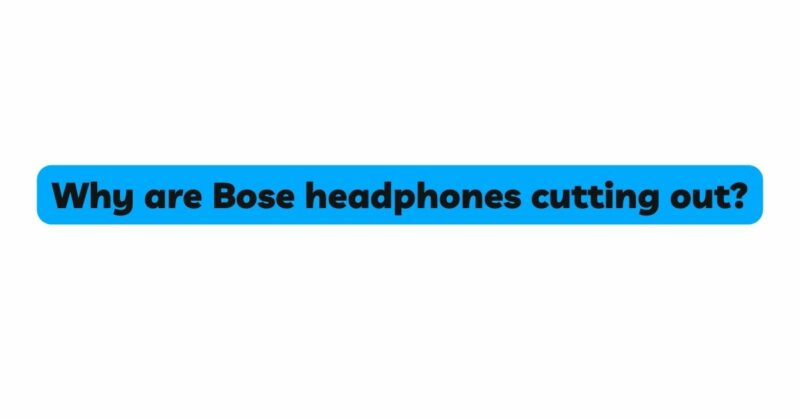Bose headphones are renowned for their exceptional sound quality and innovative technology, making them a popular choice among audio enthusiasts. However, despite their reputation for excellence, some users have encountered the frustrating issue of their Bose headphones cutting out unexpectedly during use. This phenomenon disrupts the listening experience, leading users to wonder why their reliable headphones are now experiencing intermittent audio interruptions. In this comprehensive article, we will explore the most common reasons behind why Bose headphones may be cutting out and delve into practical solutions to resolve these interruptions, allowing users to fully enjoy their audio experience.
- Wireless Signal Interference
Many Bose headphones utilize wireless technology, such as Bluetooth, to connect to audio sources like smartphones, laptops, or music players. One of the most common reasons for audio cutouts is wireless signal interference. Bluetooth operates on the 2.4GHz frequency band, which is a commonly used spectrum for various wireless devices, including Wi-Fi routers, cordless phones, and other Bluetooth peripherals.
When multiple devices are actively transmitting in this frequency range, interference can occur, leading to audio dropouts in the headphones.
Solution: To mitigate wireless signal interference, users can consider the following:
a. Keep the headphones and the connected device in close proximity to improve signal strength and stability. b. Reduce the number of active Bluetooth devices in the vicinity, especially those that operate on the 2.4GHz band. c. Ensure both the headphones and the audio source have the latest Bluetooth firmware and drivers installed to take advantage of potential improvements and bug fixes.
- Low Battery Level
For wireless Bose headphones, a low battery level is a common culprit for audio cutouts. When the battery power diminishes, the headphones may struggle to maintain a stable Bluetooth connection, leading to frequent interruptions.
Solution: Always charge the headphones fully before use and maintain their battery health by following the manufacturer’s recommendations. Regular charging and avoiding complete battery depletion can help prevent audio cutouts due to low battery levels.
- Firmware and Software Updates
Firmware and software updates play a vital role in optimizing the performance and stability of Bose headphones. Neglecting to install the latest updates may result in connectivity issues and audio dropouts.
Solution: Check for firmware updates through the official Bose Connect app or the Bose website. Ensure that both the headphones and the connected device have the most recent updates installed to improve compatibility and minimize audio interruptions.
- Outdated Bluetooth Version
Mismatched Bluetooth versions on the headphones and the connected device can lead to compatibility issues and audio cutouts. For example, if the headphones use an older Bluetooth version (e.g., Bluetooth 4.1), they may experience difficulty connecting or maintaining a stable link with a device using a newer Bluetooth version (e.g., Bluetooth 5.0).
Solution: Verify the Bluetooth version supported by both the headphones and the paired device. If a significant mismatch exists, consider using an alternative device or upgrading the headphones to ensure compatibility.
- Multiple Paired Devices
Bose headphones often offer the convenience of pairing with multiple devices simultaneously. However, this feature can lead to audio cutouts when the headphones try to switch between devices or when multiple devices attempt to connect simultaneously.
Solution: Disconnect the headphones from all paired devices and then reconnect them to the desired device. This process will establish a fresh and stable connection, reducing the likelihood of audio interruptions.
- Physical Obstructions
Physical obstructions between the headphones and the connected device can weaken the Bluetooth signal, leading to audio cutouts. Walls, furniture, or even the human body can attenuate the signal strength, especially when the headphones and the device are far apart.
Solution: Position the headphones and the audio source in direct line of sight with minimal obstructions between them. Reducing the distance between the two devices will also help improve the signal strength and reduce the occurrence of audio dropouts.
- Headphone Software Glitches
Occasionally, software glitches within the headphone’s operating system or internal circuitry can cause audio cutouts. Such issues may arise from bugs, memory leaks, or conflicts between different processes running on the headphones.
Solution: Reset the headphones to their factory settings, following the manufacturer’s instructions. This action can resolve software-related glitches and restore the headphones to their default state.
- Environmental Interference
Environmental factors, such as other electronic devices or strong radio frequency signals in the vicinity, can interfere with the headphones’ wireless connection and lead to audio cutouts.
Solution: Move away from potential sources of interference or test the headphones in different environments to identify if external factors are contributing to the audio interruptions.
Conclusion
Experiencing audio cutouts with your Bose headphones can be frustrating, but understanding the underlying reasons behind this issue is the key to finding effective solutions. Whether it’s wireless signal interference, low battery levels, outdated Bluetooth versions, or environmental factors, the solutions provided in this article should help you troubleshoot and rectify the problem. Regular maintenance, staying updated with firmware, and being mindful of your headphone usage can go a long way in ensuring a seamless and uninterrupted listening experience with your Bose headphones. With these insights in hand, users can confidently address audio cutouts and continue to enjoy the exceptional sound quality that Bose headphones are renowned for.


